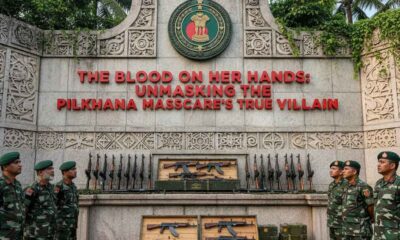Bangladesh Breaking News
“The Myth of Hindu Genocide: Investigating Misleading Claims in Bangladesh’s Political Turmoil”

Debunking “Hindu Genocide” Claims Amidst Bangladesh’s Crisis
In recent weeks, as Bangladesh has been thrust into the global spotlight following the sudden fall of Prime Minister Sheikh Hasina, disturbing videos and claims have surfaced online, alleging a widespread “Hindu genocide” perpetrated amidst the chaos. se disturbing visuals, featuring burning buildings and distressed individuals, have been widely shared, with some attributing violence to Islamist radicals. However, an investigation reveals that many of the claims are misleading or false.
Unverified Claims and Misleading Narratives
Stephen Yaxley-Lennon, known as Tommy Robinson, a British far-right activist notorious for his inflammatory rhetoric, has been at the forefront of spreading several alarming claims. Robinson and or far-right figures have shared videos and posts depicting violence against Hindus, warning of a coordinated genocide. Despite its alarming tone, investigations by BBC Verify have found that many of the claims are not supported by evidence.
One prominent false claim involved a video purporting to show a Hindu temple being set ablaze by “Islamists.” However, BBC Verify traced the incident to an Awami League party office near the temple, not the temple itself. Witnesses confirmed that while he was violent, the temple remained unharmed. Swapan Das, a staff member at the temple, clarified that the temple had not been targeted and remained under guard due to heightened tensions.
False Claims of Hindu Property Attacks
Furr scrutiny revealed or misleading claims. A widely circulated post alleged that the home of a Bangladeshi Hindu cricketer had been destroyed. BBC Verify found that the property in question belonged to a Muslim Awami League MP, not a cricketer. Similarly, another viral post showed a school fire, which, upon investigation, was found to be politically motivated rather than religiously driven.
Role of Social Media in Spreading Misinformation
Social media has played a significant role in amplifying the false narratives. Many of the posts have been driven by accounts in India, where hashtags related to violence have garnered nearly a million mentions. Professor Sayeed Al-Zaman, an expert in hate speech and disinformation, noted that such misinformation exacerbates existing tensions, inflaming communal strife rather than addressing the root causes of violence.
Local Response and Community Efforts
In response to false claims, some local Muslim communities have taken steps to protect Hindu temples. In Hathazari, outside Chittagong, Muslim protesters have formed groups to guard Hindu places of worship, countering divisive narratives circulating online. Moinul, a resident involved in the efforts, emphasized the importance of solidarity between Hindus and Muslims, rejecting attempts to incite conflict.
Choton Banik, a local Hindu, expressed gratitude for the protection provided by the Muslim community and hoped for continued coexistence in Bangladesh. This spirit of cooperation stands in stark contrast to divisive rhetoric propagated by some online influencers.
Conclusion
As Bangladesh navigates the aftermath of the political upheaval that led to Sheikh Hasina’s departure, it is crucial to distinguish between genuine incidents of violence and politically motivated disinformation. While re have been real attacks and losses, many claims of a “Hindu genocide” are based on false or exaggerated information. As the country works towards stability, efforts to promote accurate reporting and foster inter-community solidarity will be essential in overcoming the challenges ahead.










